The Five Most Valuable Online MBAs

Choosing an online MBA program isn’t easy. Not only do you need to look at rankings, but you also have to look at what the program offers and how affordable it is. After all, the goal of an online MBA is a great return on investment. So, how do you find the most valuable Online MBA programs?
We’ve searched through the U.S. News and World Report on the “Best Online MBA Programs” to find which ones can give you the best experience at the best cost.
The programs on this list rank in the top 25 “Best Online MBA Programs,” and cost under $1,400 per credit.
The Five Most Valuable Online MBA Programs
Indiana University
Tied for first as the best online MBA program in the country, Indiana University’s Kelley School of Business is also affordable.
The Kelley Direct Online program offers the ultimate in flexibility. Students can take between two to four years to graduate and tailor their classwork to their goals. Online MBA students will cover such topics as business law and ethics, economics, marketing, finance, operations, information technology, and project management. They’ll also have the opportunity to study abroad in one of Kelley’s global hubs located in Botswana, Brazil, China, India, Myanmar, South Africa, and Cuba.
- Cost: $1,330 Per Credit (out-of-state)
- Ranking: #2
Arizona State University
Ranked as the 5th best online MBA program in the U.S., Arizona State University’s W.P Carey School of Business won’t break the bank either.
The Online MBA at ASU is designed to work with students no matter where they live. The program is incredibly flexible with just five weeks per class and 17 total classes. Interested students can expect to take classes covering a range of topics including strategic management and global thinking. Classes start in either January or August with students taking the same curriculum taught by the same faculty as the full-time and part-time programs.
- Cost: $1,216 Per Credit (out-of-state)
- Ranking: #5
University of Florida
Ranked at 6th overall, the University of Florida Hough Graduate School of Business also offers an affordable online MBA program.
The UF Online MBA offers the ideal balance of work, life, and school commitments. Students can graduate in just 24 months without visiting campus, with courses taught by the full-time MBA faculty. Students cover the same topics as their full-time brethren with courses on financial accounting, economics, and more. There is also an optional Global Immersion Experience opportunity.
- Cost: $1,255 Per Credit (out-of-state)
- Ranking: #6
Lehigh University
Ranked at 19th on the U.S. News and World Report list, the online MBA at the Lehigh University’s College of Business and Economics is incredibly affordable.
The Online Flex MBA at Lehigh University is AACSB accredited and places high emphasis on maintaining excellence. Students can complete the program in as little as 16 months while taking classes on a variety of topics including managing financial and physical resources, corporate entrepreneurship, international business, and marketing. Students can also choose to pursue a concentration in one of six fields including: corporate entrepreneurship, finance, international business, marketing, project management, and supply chain management.
- Cost: $1,075 Per Credit (out-of-state)
- Ranking: #19
University of Delaware
The University of Delaware’s Lerner College offers the most affordable online MBA on our list while still ranking in the top 25.
Last but certainly not least, the Lerner Online MBA is designed to provide students with the decision-making skills and analytical tools to succeed. The program is entirely online with a customizable curriculum that can be completed in as little as 16 months. In addition, students can choose between five concentrations including business analytics, finance, healthcare, strategic leadership, and international business. Each course is seven weeks long and taught by a Ph.D.-qualified faculty member.
- Cost: $812 Per Credit (out-of-state)
- Ranking: #22
Runner’s Up
- University of Texas at Dallas: The Naveen Jindal School of Management’s Online MBA program is ranked #6 in the nation and costs $1,402 per credit (out-of-state).
- Hofstra University: The Zarb School of Business Online MBA ranks 36th on the list and costs just $1,596 per credit (out-of-state).
- Syracuse University: Ranked 42nd, the Syracuse University Online MBA costs just $1,500 per credit.
New MBA Jobs: Goldman Sachs, Walmart, Coca Cola, and More

A new week means a new rundown of the best new MBA jobs out there! This list features entry level positions and roles for seasoned vets, so there’s something for everyone here. Apply today and get your post-MBA career started right away!
October MBA Deadlines: NYU Stern, Ivey, Lehigh, and More
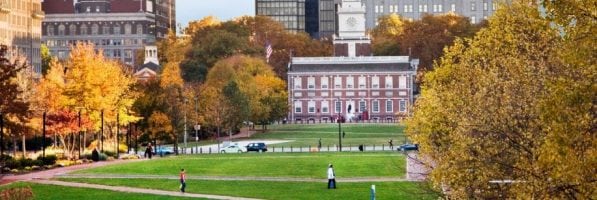
Douglas Adams once wrote, “I love deadlines. I love the whooshing noise they make as they go by.” Prospective MBAs applying for business school can appreciate Adams’ humorous writing, but should do their best to not live by the British author’s procrastinating prose. That’s where MetroMBA comes in! Check out our list of upcoming MBA program application deadlines in our top metros: Continue reading…
MBA Deadline Dates You Should Know in September

September may mean that summer’s over, but it’s also a time to start to look forward to new beginnings! Stay on track of September MBA deadlines and get those mid-fall and winter program intake applications in. Continue reading…
New MBA Jobs: McKinsey, AT&T, Barclays and More

Big time companies are hiring in some the world’s most bustling metros. Check out the hottest new MBA jobs at top consulting companies, supply chain departments, and financial institutions across the country below:
Are Business School Neighborhoods Becoming More Gentrified?
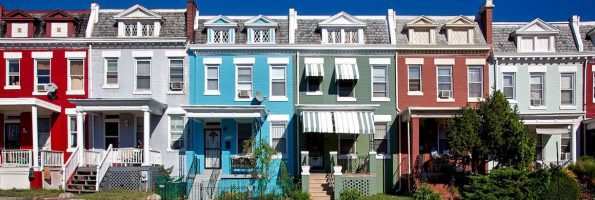
When universities are found in downtown urban areas, gentrification most often follows. It almost seems inevitable since universities bring in more individuals with higher education, draw in more money, and increase new businesses. But what does the rapid increase of gentrification statistics mean for the business school students looking to start their career in a new area?
What Is Gentrification?
First, we need to look at what gentrification is. In simple terms, it’s the influx of more affluent residents moving into urbanized neighborhoods. At the outset, it may sound good, but it can be controversial.
Gentrification may improve the financial quality of a neighborhood, but it can also force the relocation of current residents and businesses due to increasing costs. Often, the process of gentrification also shifts a neighborhood’s racial and ethnic composition, as well as the average household income. This can lead to community displacement for lower-income families in gentrified areas, some of which often live in the area for several generations.
However, there is a grey area. Gentrification happens when a location becomes increasingly attractive. At that point, more high-income individuals move into the area bringing in investments in the community and leading to improved infrastructure and economic development.
What Causes Gentrification?
According to a recent comprehensive review of gentrification completed by researchers at UC Berkeley and UCLA, gentrification most often occurs when more public transportation is available. People are more attracted to transit hubs because they allow more privileged groups to trade car commutes for transit and signal a large-scale commitment to neighborhood upgrading, which, in turn, leads to increased employment opportunities.
Another spur to gentrification is education. Quality schools, universities, colleges, and medical centers tend to shape gentrification. The substantial federal support that public universities receive brings money into neighborhoods through many means including housing and housing subsidies for faculty and staff. A CityLab study revealed that universities and other academic institutions are key to attracting the creative class, creating more market demand and political pressure for better amenities, schools, and other services.
Analyzing University Neighborhood Gentrification Statistics
Since universities have such an impact on gentrification, we thought we’d take a look at what areas and schools have been most affected. While gentrification is not something most urban areas should aspire for, it happens, and it’s important to know where it’s occurring the most.
To find out, we looked at a recent study by RentCafe of the most gentrified areas in the U.S. The study took a look at the 2000 Census and the 2016 American Community Survey to see the changes that took place over a decade and a half across 1,000 U.S. ZIP codes. The study found that there are easy ways to quantify gentrification statistics when looking at median home value, median household income, and the population that holds a bachelor’s or higher degree.
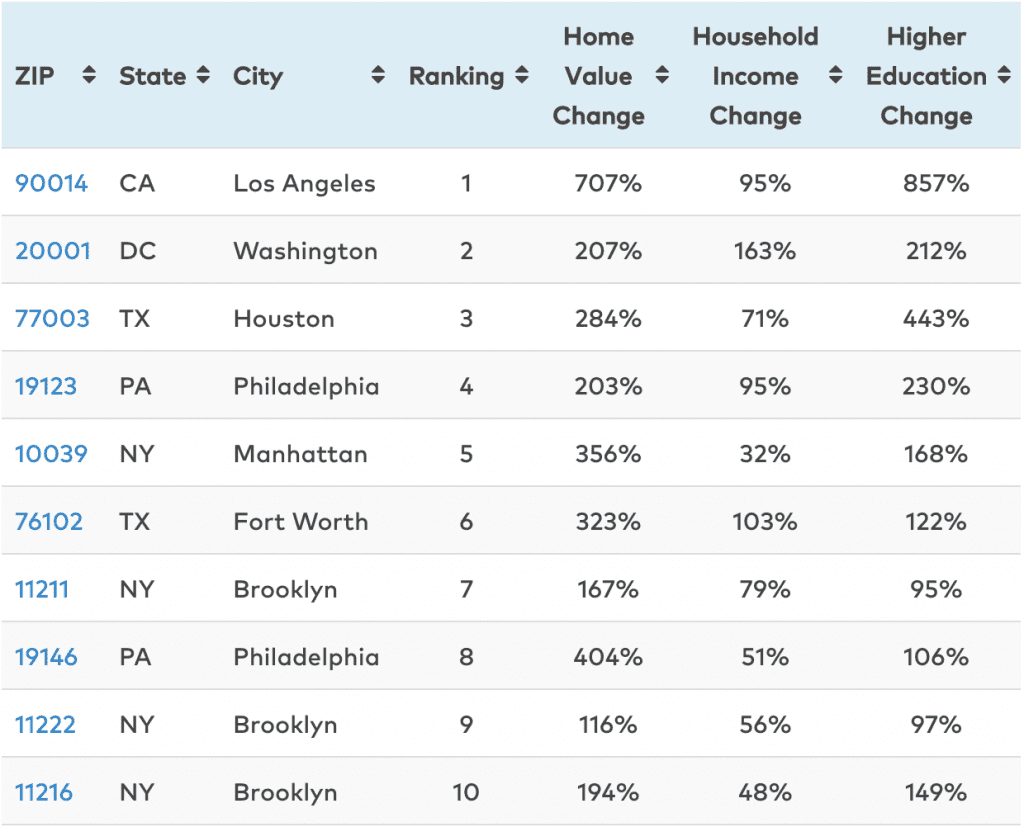
Based on the results of the study, we analyzed the top five MetroMBA universities in gentrified areas.
-
University of Southern California
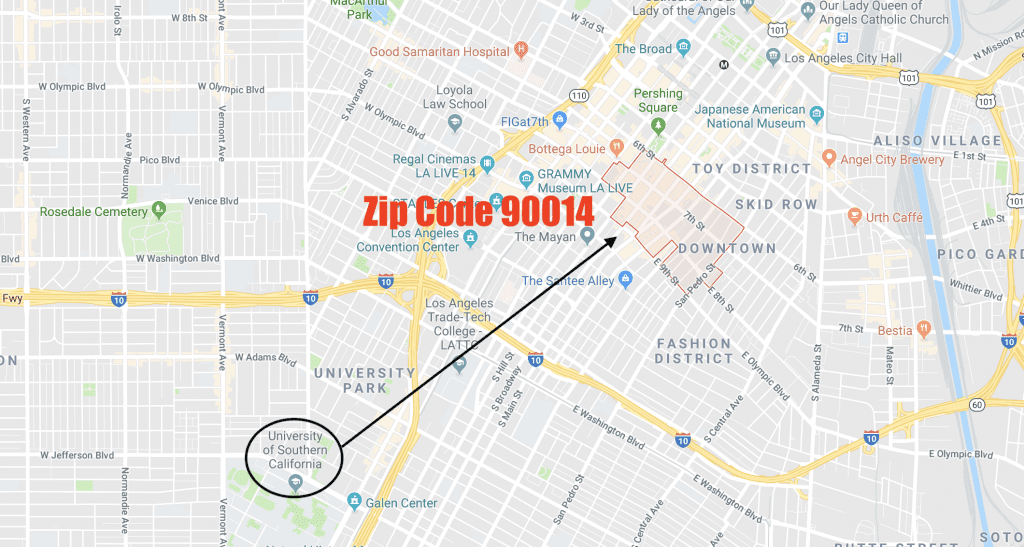
Located less than five miles away from ZIP code 90014 in Los Angeles, USC Marshall is just on the edge of the most gentrified area in the U.S. Over the last 16 years, this area has witnessed:
- A 707 percent increase in home values
- A 95 percent increase in median household income
- And an 857 percent increase in people holding bachelors or higher degrees
So, while some at USC might be fighting gentrification, it may not be working. Just last year, USC opened up a brand-new $700 million USC Village with a Target Express, Trader Joe’s, and 15 restaurants, transforming the surrounding neighborhood. And even though as part of the development USC provided $20 million for construction of off-site subsidized housing, there are still concerns.
“Across the street, land values are going to increase,” Joe Donlin, Associate Director of Strategic Actions for a Just Economy, told KPCC. “We know the landlords are going to rent at higher levels of rent.”
-
Howard University
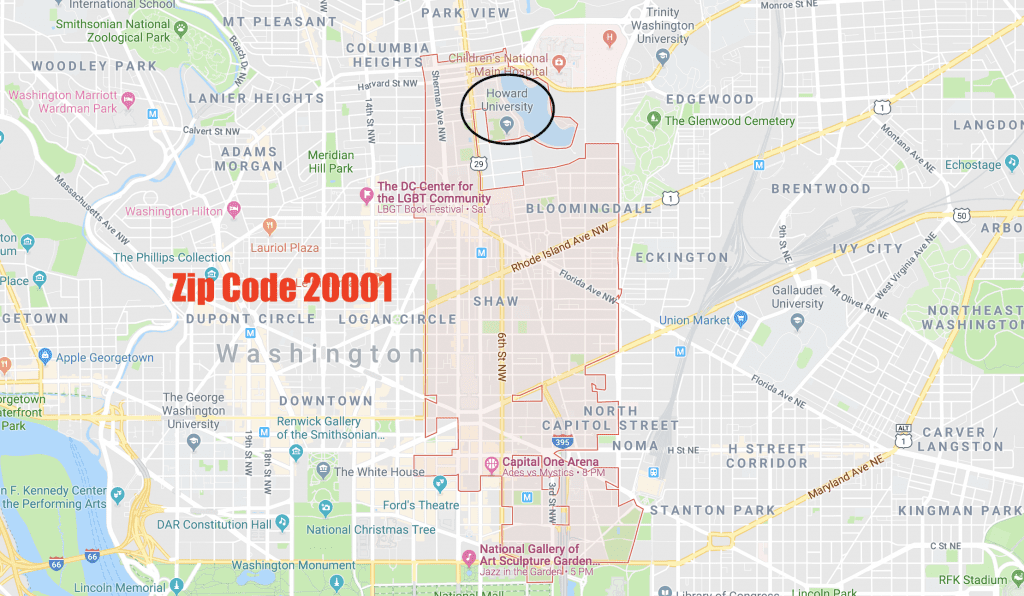
Located in Washington, D.C. Zip Code 20001, Howard University’s campus is located directly in the second most gentrified area in the U.S. Over 16 years, the area has witnessed:
- A 207 percent increase in home values
- A 163 percent increase in median household income
- And a 212 percent increase in people holding bachelors or higher degrees
The gentrification statistics of the Howard University area hasn’t gone unnoticed. According to NPR, there has been a drastic change:
“The area, located just a couple of miles north of Capitol Hill, was once working-class and black. But as hundreds of new residents move to D.C. each month, more non-black residents move into Howard’s neighborhood. And as property values rise, the university is trying to capitalize on the hot real estate market.”
-
University of Houston — Downtown
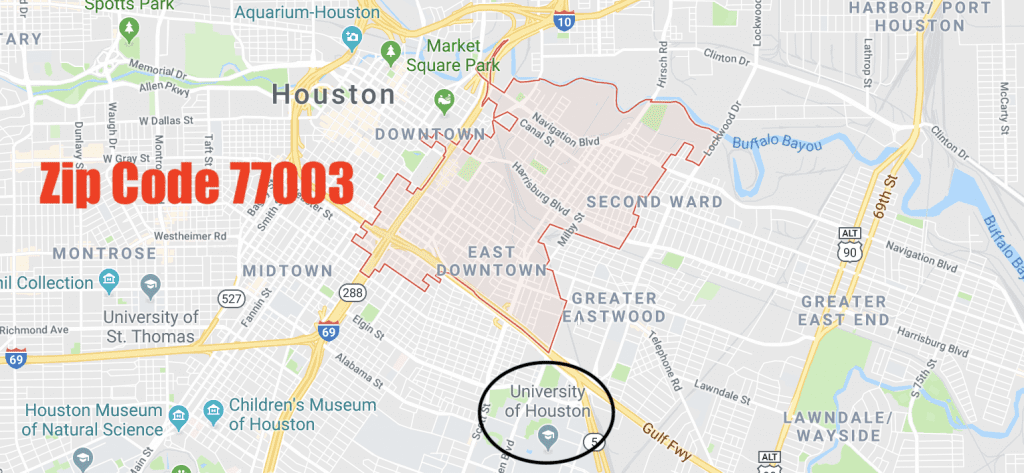
Located just steps away from zip code 77003, The University of Houston campus is located near the third most gentrified area in the U.S. In the last decade and a half, the area has seen:
- A 284 percent increase in home values
- A 71 percent increase in median household income
- And a 443 percent increase in people holding bachelors or higher degrees
Much of the gentrification can be laid at the university’s feet as its student housing footprint has expanded into surrounding neighborhoods over the last decades. According to the Houston Chronicle, “In the portion of the neighborhood closest to downtown, which includes Emancipation Park, median home values increased 176 percent between 2000 and 2013, according to an analysis of census estimates conducted by Governing.”
-
University of Pennsylvania
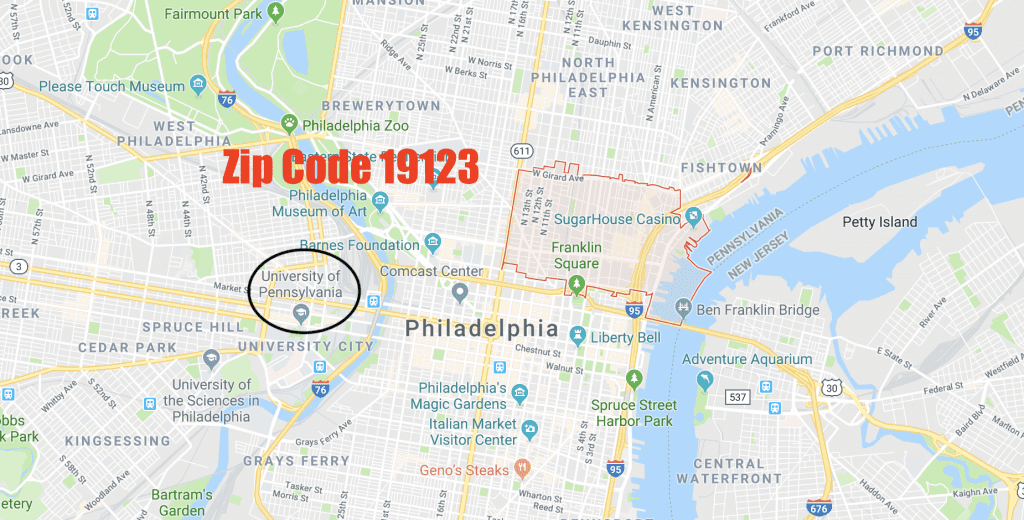
The Wharton School at UPenn is less than five miles outside the fourth most gentrified neighborhood in the country: zip code 19123. This area, over the last 16 years, has noticed:
- A 203 percent increase in home values
- A 95 percent increase in median household income
- And a 230 percent increase in people holding bachelors or higher degrees.
In fact, UPenn has had a complicated history with gentrification over the years, dubbed Penntrification by some. The problem, according to The Daily Pennsylvania, is that in West Philadelphia Penn students’ demand for housing is displacing low-income families. There have even been protests criticizing the university for causing gentrification in the area.
-
Texas Christian University
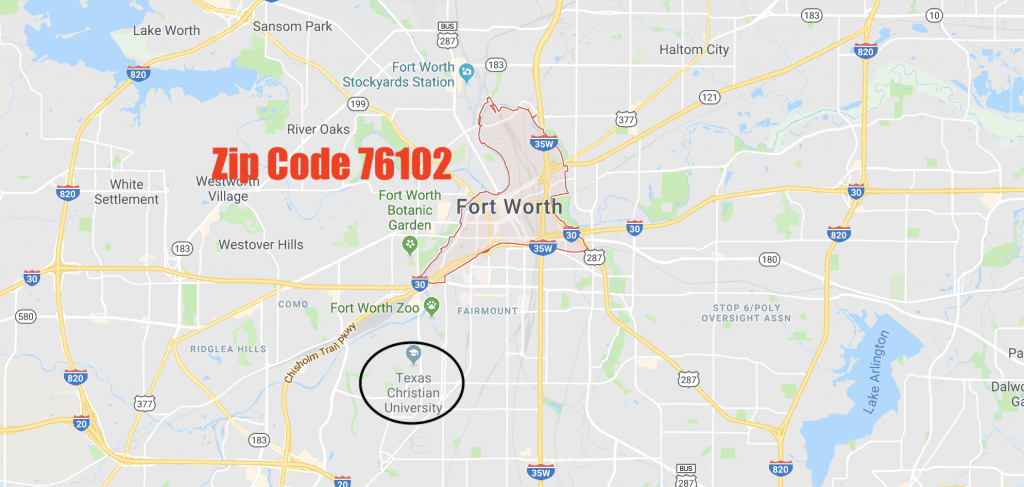
Fort Worth, TX, contains the sixth most gentrified area in the U.S.; just two miles away from Texas Christian University (TCU). Over 16 years, the area has witnessed:
- A 323 percent increase in home values
- A 103 percent increase in median household income
- And a 122 percent increase in people holding bachelors or higher degrees
While Fort Worth’s growth has brought new life to the city’s urban core, it’s also sky-rocketed property values. In particular, the areas around TCU are growing quickly. The university recently completed a $100 million renovation for its football stadium—just five years after its last overhaul, which reportedly cost $164 million.
